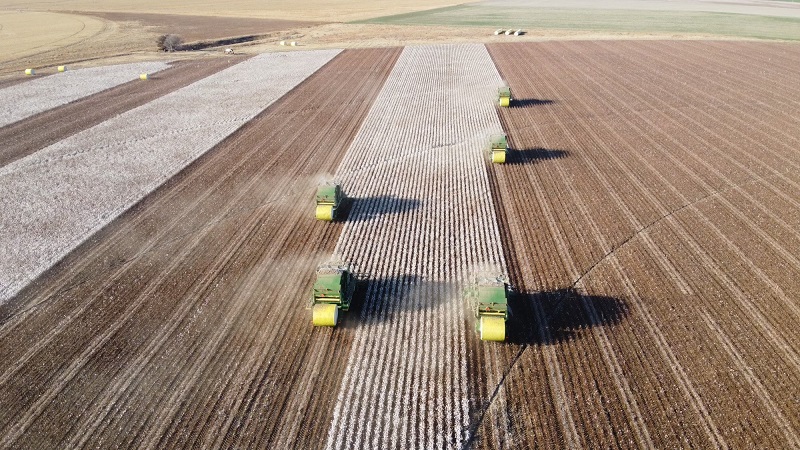Plexus: Market Continues to Meander Sideways
New York futures came under renewed pressure this past week, as December dropped 304 points to close at 65.05 cents.
The market was unable to hold on to the impressive gains it posted a week ago and dropped right back to the middle of a 62.00 to 68.50 cents range, which has been in effect for about nine weeks now. Nevertheless, December has so far managed to stay above a short-term uptrend line dating back to August 1, as well as a longer-term downtrend line that originated in early May. These two lines crossed just below 64.50 cents last week. As long December can stay clear of that level, the bulls have something to hang on to.
Markets don’t like uncertainty, and the cotton market has been shrouded in plenty of it lately, which is why we have seen this meandering sideways trend for the last two months. China’s government policy and unpredictable weather are keeping traders on their toes, and either one of them has the power to unsettle the market.
China finally confirmed what had been rumored for a while – that Xinjiang producers would be receiving a target deficiency payment, amounting to the difference between the target price of 19,800 yuan/ton and an average market price based on data collected between September and November. At current rates, the subsidy would probably exceed 6,000 yuan/ton (44 cents/lb). Growers in the eastern cotton belt of China are less fortunate, since they will apparently only get a fixed subsidy of 2,000 yuan/ton (15 cents/lb), which means that their revenue will likely fall 20 to 25 percent below that of last season.
However, it is still not clear how China will proceed on cotton imports, which is the most important factor when it comes to international prices. According to some sources, the government seems to be quite determined to slow down imports, allowing only the one percent TRQ and some processing quotas from here on out. Mills may even be required to earn their TRQ by buying Xinjiang cotton between now and December, possibly on a ratio scheme. This sounds like a clever way to support cash prices and thereby lessen the government’s subsidy burden.
The market now fears that Chinese imports may not quite live up to the USDA estimate of 8.0 million bales for the current season, which, in turn, would lead to higher rest of world (ROW) stocks and depress prices even more. However, this view may be too pessimistic, since there are still quite a few open quotas around from earlier this year when mills decided to wait for lower prices. Between these unused quotas, next year’s TRQ and some additional processing quotas, we may still see imports climb to 8.0 million bales by next July.
Beyond that, the pace of Chinese imports may indeed slow down, but the ROW surplus is likely to drop as well since these lower prices should discourage production and stimulate mill use. In the current season, the ROW is expected to produce a surplus of 12.9 million bales, and in 2015/16, we could easily see this surplus drop to 6.5 million bales. All it would take is for ROW production to drop by five percent to 84.0 million bales, while ROW mill use increases by 2.5 percent to 77.5 million bales.
Such a scenario is certainly plausible, given the depressed price level we are at – and may even prove to be conservative. Therefore, as long as China keeps absorbing the diminishing ROW surplus, price pressure shouldn’t increase.
Chinese yarn imports, which are not subject to quotas, are another important factor to consider. Many traders believe that the drop in Chinese domestic prices will negatively impact yarn imports. However, it is no secret that Chinese mills generally prefer imported versus local cotton for quality reasons. Therefore, if raw cotton imports become more restricted, mills may increasingly turn towards yarn imports.
Although the price difference between China and the ROW has narrowed considerably this season, it should still be enough to make yarn imports work. January futures are currently trading at 13,500 yuan/ton, which equates to around 100 cents/lb and is 26 cents above the A-index. We would therefore not be surprised if yarn imports were to exceed expectations this season.
So where do we go from here?
China’s subsidy announcement has reinforced the negative mood that has prevailed in our market since it started raining in West Texas nearly four months ago. However, even though the bears are out in full force discounting offering prices for January onwards, the nearby situation has not changed at all. The pipeline is still empty, and parts of the U.S. crop are getting further behind due to rainy and cool conditions.
We are still in a weather market at this point and it will take another six weeks before traders have a better grip on what to expect in terms of quality and quantity.
Since the certified stock is all but gone, traders will think twice before shorting December at 64 cents or lower. December is therefore acting like an obstacle to a more bearish scenario that follows behind it, which means that we may be stuck in a sideways trend for a while longer.
THE ABOVE IS AN OPINION, AND SHOULD BE TAKEN AS SUCH. WE CANNOT ACCEPT ANY RESPONSIBILITY FOR ITS ACCURACY OR OTHERWISE.
Source – Plexus









